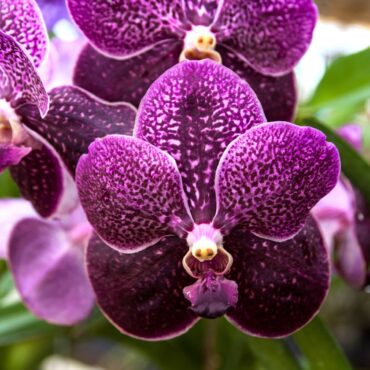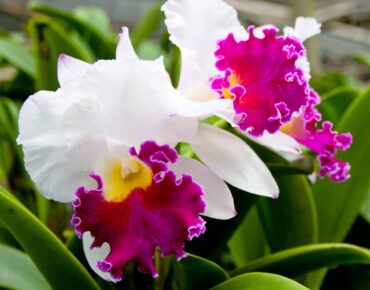
Orchidaceae, the Orchid family, is a diverse group of flowering plants belonging to the Liliopsida class. Found on every continent except Antarctica, orchids are one of the largest families of flowering plants. With more than 28,000 species, there are more orchids on the planet than mammals and birds
According to fossil research, orchids have been around for approximately 100 million years. Centuries ago, these blooming beauties were once seen as a rare and luxurious item to own. However, by the 19th century, advanced growing techniques allowed various types of orchids to become more accessible to home gardeners all around the world.
Different Types
The vast orchid family includes commonly cultivated plants like Phalaenopsis or Cattleya as well as the Vanilla plant, one of the primary sources of the ever-popular flavoring. Most orchid types in the market today are hybrids that have been bred for their gorgeous blooms and ease of care in the home.
When choosing an orchid to purchase, it is important to learn about its natural environment and conditions to give it the best chance of thriving in your home.
- Phalaenopsis, also known as the moth orchid, is popular for its easy care and large, long-lasting blooms, making it a great addition to the beginning house plant hobbyist’s collection.
- Cattleya is often called the queen of orchids. With proper care, cattleyas can bloom in the home year after year.
- Oncidium are commonly referred to as the “dancing lady” orchid due to their highly modified, ruffled blooms.
- Dendrobium are a large group of orchids that boast many pastel-toned blooms.
- Vanda orchids have flat flowers and bloom several times a year under greenhouse-like growing conditions. They are most well known for their cascading root systems that can be difficult to contain in a pot.
- Cymbidium flower spikes can last from one to three months with a natural blooming season during the winter. Cymbidium are commonly referred to as “boat orchids” because of the shape of their lip.
- Sobralia are characterized by short-lived, colorful flowers and are often found in hobbyist collections.
- Vanilla planifolia are one of the primary sources of vanilla flavoring. Vanilla blooms are small and only appear once per year.
- Paphiopedilums are easily grown as houseplants and are more commonly known as the “slipper orchid” due to the slipper shape of the bloom’s lower pouch.
- Brassavola orchids have narrow white petals that release a fragrant perfume in the evenings.
Orchid Care
In nature, many orchid types are epiphytes, meaning that they attach to tree branches and take in nutrients from decaying bark and tropical rains. But, in order to bring orchids to our homes, most are planted in a rooting medium that lends itself to the unique epiphytic roots.

Orchids are amazing plants because their visible roots can indicate how much moisture they need. If the plant needs more moisture, the roots will look silvery. Severely dehydrated roots look wrinkled and tan. On the flip side, dark and mushy roots are overwatered and beginning to rot. The goal is plump roots that are green after watering, returning to a silvery-green color as they dry off.
Speaking of moisture, the best way to water an orchid is by drenching the root ball (do not use salt-softened or distilled water) in room temperature water to thoroughly wet the media. Do this every week or two. Allow the plant to drain well, then place the pot on a tray or saucer filled with gravel or pebbles that will provide humidity. Never allow orchid roots to sit in water. The ice cube method of watering has been researched by OSU and UGA and is proven to be a viable option, especially for new plant parents uncertain about how to properly water their new orchids.
In their natural habitat, orchids receive filtered light under the protection of the forest canopy. However, orchids grown indoors need to receive quite a lot of indirect sunlight to thrive and produce blooms. The best growth activity occurs when the orchid receives 10-16 hours of indirect light. Just be sure to protect them from harsh sun rays, as they can easily get sunburnt.
Orchids do not like “wet feet,” but they do appreciate a bit of humidity. Try placing your plant on a humidity tray to help increase the immediate atmospheric humidity around the plant.
Many orchids have a reproductive (flowering) cycle and a vegetative (nonflowering) cycle. Basically, what this means is that your plant will spend a period focusing on flower production and a period focusing on leaf and root production. During the vegetative cycle, it’s actively recovering and preparing to reflower, so it’s key that you provide the water, light and nutrients it needs to recover. Orchids can remain nonflowering/vegetative for six to nine months before producing a new bloom, so don’t get discouraged if you don’t see results right away. Patience is key.
Top Orchid Tips
- Orchids love long periods of indirect light. The best growth activity occurs when the orchid receives 10-16 hours of indirect light. A good test to see if the location in question is adequately lit for your plant is to hold your hand up and check the shadow. If the shadow is blurred, you’re good to go. If it’s more distinct, the light level is too high.
- Several air roots are a good sign that your plant is actively growing. If possible, don’t trim air roots back unless they are dead or rotten. Trimming roots can cause growth stunting.
- When repotting orchids, use clear containers with drainage to allow you to periodically check root health.
- Keiki are daughter plants that are grown at nodes on the flower spikes of the mother plant. Basically, the orchid is self-propagating. If your keiki is already producing its own leaves and two to three roots, you can trim it off and plant it in its own pot.
- Although most people don’t realize it, many orchid types have spikes that are a temporary flower structure. They exist as long as the plant is in its reproductive lifecycle. Once the plant has finished flowering, its flower spike dies. New flower spikes produce the new flowers in the future. This is why spike trimming is necessary after the flower dies.
- Many types of orchids can stay vegetative (nonflowering) for years if they don’t receive the right environmental signals to flower. Try moving your plant to a north or east-facing windowsill in winter months to trigger a new flower spike.
- Phalaenopsis orchids need a period of cool night temperatures for four to five weeks before initiating flower spikes. Temperatures near 65 F at night are a good place to start for home growers. This can be as simple as placing the orchid near a north or east-facing window in winter months.
- Light is key when trying to achieve blooms. If you’re struggling to obtain flower spikes, you may try to increase the length of indirect light your plant receives during the day. This does not mean that you need to increase light intensity, but rather the amount of time your plant receives light.
- After the orchid drops its last flower, trim the flower spike. You can trim it back in one of two ways depending on your plant’s situation. If the spike is still green, it means that your plant potentially has the energy to push out a new flowering spike from the current spike. It speeds up the process of reblooming to simply cut the spike back 1 inch above the highest node, or bump, on the spike. For unhealthy, brown spikes, cut all the back to the base of the plant.




























